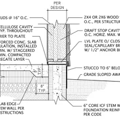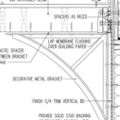What’s better: 4 inch SIPs with 2 inch XPS or 6 1/2 inch SIPs only?
This question is just about efficiency, not about cost. The house will be Thermocore SIPS, but we are trying to decide on 4″ SIPS with 2″ XPS on outside, or 6-1/2″ SIPS with no foam.
4″ SIPS = R-24 + R-10 for 2″ XPS, total R-34.
6-1/2″ SIPS = R-40.
once I figure the savings on the SIPS, but add the materials & labor for the foam, plus a couple of other items, the cost difference is almost a wash.
The R-value with the 6-1/2″ is better, but using the 4″ with XPS foam will eliminate the small bit of thermal bridging that will occur at the top & bottom plates, wall intersections, etc.
What would be better, the higher R-value, or less thermal bridging?
Thanks!
Allen Brown
GBA Detail Library
A collection of one thousand construction details organized by climate and house part










Replies
Allen,
Adding rigid foam to the exterior side of SIPs is somewhat controversial. I have defended the practice in the past, but with the increasing availability of mineral wool insulation, I now think that mineral wool is a safer bet than rigid foam for the exterior side of SIPs.
To read a variety of opinions on this topic, you may want to seeHow to Make a SIP Roof Better.
To read about air sealing SIPs, seeHow to Protect Structural Insulated Panels from Decay.